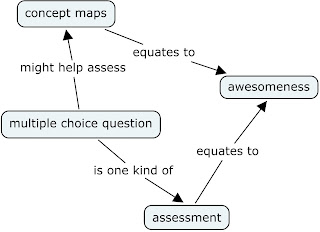All the
glossy magazines tell us that direct-to-consumer personal genomics is upon us and that our individual futures can now be predicted. Just because the science behind the predictions is (ahem) under-ripe does not mean that the whole venture is destined for extinction. Today’s undergraduates are highly likely to be consumers of information about their own genome and I hope they turn out to be informed ones. To this end, I’ll be integrating the topic of personal genomics into a two-class module on complex trait inheritance for a small introductory biology course. Next week.
So, yes, I’m feeling sleep deprived and jittery and I’m starting to dream about vanishing learning objectives, the way I used to dream about pushing electrons and sliding redox states as an undergrad. It’s only thanks to the mentoring of some helpful faculty members that I haven’t already burst into flames.
Assuming my lack of spontaneous combustion lasts until next Friday, this is what I’m thinking of trying:
Class I (2h minus break)
1) Social implications of disease testing – group disccusion of the
reading
2) Huntington’s disease minilecture: Pedigrees, linkage and finding causative mutations by looking for markers physically linked to them
3) Activity drawing linked and unlinked alleles on chromosomes through the steps of meiosis and crossing over
4) Introduction to complex traits – examples of muliple genetic influences, environmental influences and gene x environment interactions
5) Brainstorm on ‘what is environment?’
6) Group activity on coming up with experimental designs to decide whether genetics or environment has more influence on a trait
7) Introduction to heritability
8) Think-pair-share on example of heritability misconception
Class II (2h minus break)
1) In-class quiz on homework problem set
2) Introduction to genome-wide association studies as a way to find linkage for complex traits and the current limitations on risks predicted from them.
3) In small groups, use the 23andMe demo genomes and answer guided questions to relate their existing knowledge of genes and alleles and loci and punnett squares and dominance relationships to the SNP genotypes on the screen. Group discussion of results.
4) Small groups each prepare a short genetic counselling session for either Lilly or Greg. Guided by fictional case notes for each that change the interpretation of the results.
5) Group synthesis of our interpretations of absolute vs. relative risk, genetic vs. environmental influences, actinable vs. non-actionable information.
Absurdly optimistic? Too dumbed down? I have no idea! Help!
You may notice that class II involves mostly footling around at the
23andMe website, looking at the demo genomes of ‘Lilly and Greg Mendel’ (not their real names). If you have never done this, I highly recommend it for late-night entertainment. The thing that bothered me at first was that my class could turn into a PR exercise, in which I tacitly endorse 23andMe by forcing my students to spend nearly 2 hours exposed to their advertising material. I’ve decided to go ahead with it anyway, because it's too nice an opportunity and I can at least summarise the uncertainties that hover around SNP risk estimates at the moment.
One last thing, I promise: I got a very interesting tip from the genetics lecturer in my department today. She said that she has struggled to get students to let go of the misconception that a complex trait is just a complicated one. The confusion is revealed when they always classify multi-allelic single gene traits as complex traits. It’s possible it would be easier for them if we jettisoned the term ‘complex’ and substituted ‘multifactorial’, but I still don’t know if there is some terminological difference between the definition of complex and multifactorial traits that I have missed.




